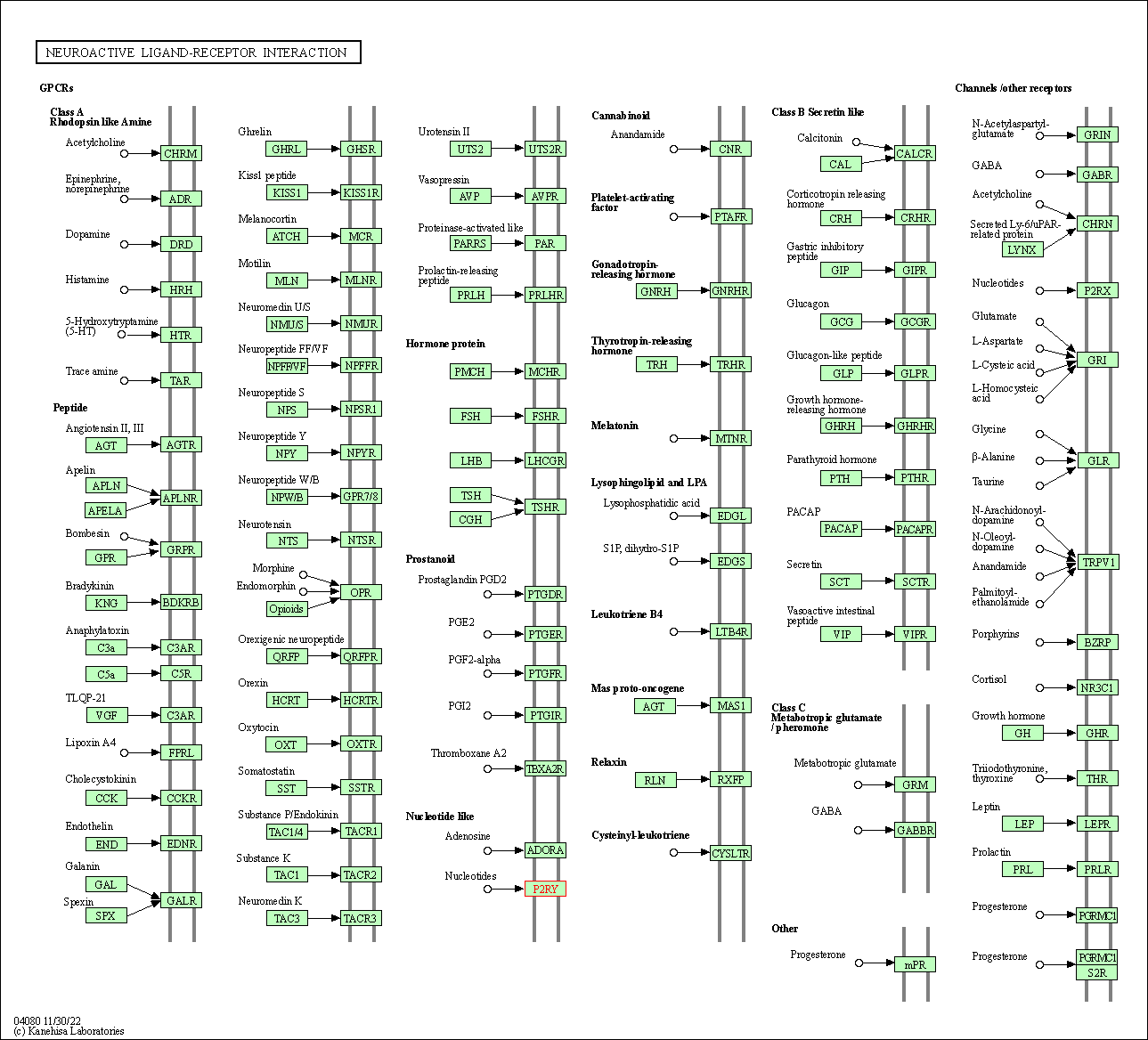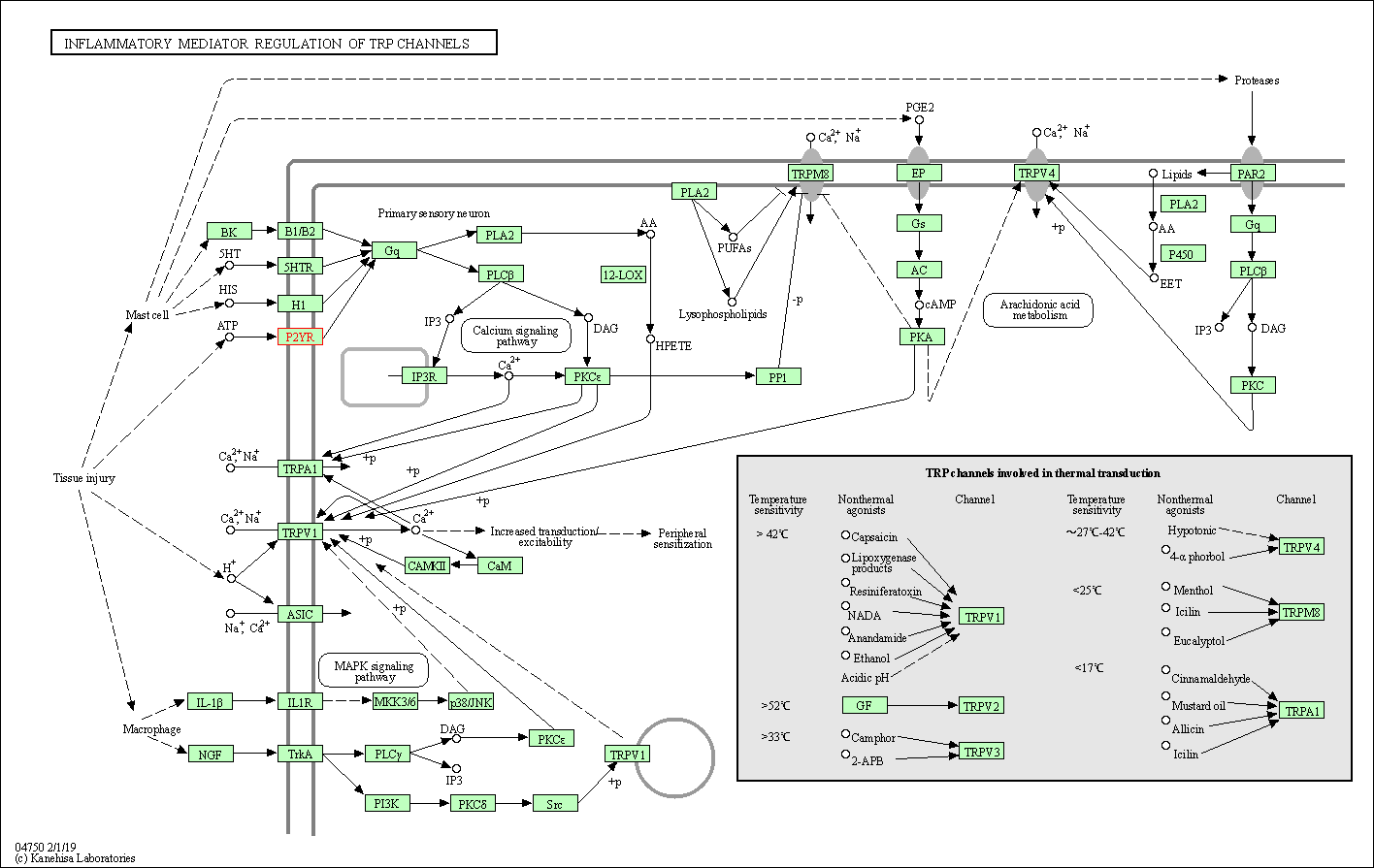Target Information
| Target General Information | Top | |||||
|---|---|---|---|---|---|---|
| Target ID |
T93515
(Former ID: TTDC00179)
|
|||||
| Target Name |
P2Y purinoceptor 2 (P2RY2)
|
|||||
| Synonyms |
P2Y2; P2U1; P2U receptor; P2U purinoceptor 1; P2U nucleotide receptor; P2RY2; Adenosine P2Y2 receptor
Click to Show/Hide
|
|||||
| Gene Name |
P2RY2
|
|||||
| Target Type |
Clinical trial target
|
[1] | ||||
| Disease | [+] 1 Target-related Diseases | + | ||||
| 1 | Visual system disease [ICD-11: 9E1Z] | |||||
| Function |
Receptor for ATP and UTP coupled to G-proteins thatactivate a phosphatidylinositol-calcium second messenger system. The affinity range is UTP = ATP > ATP-gamma-S >> 2-methylthio-ATP = ADP.
Click to Show/Hide
|
|||||
| BioChemical Class |
GPCR rhodopsin
|
|||||
| UniProt ID | ||||||
| Sequence |
MAADLGPWNDTINGTWDGDELGYRCRFNEDFKYVLLPVSYGVVCVPGLCLNAVALYIFLC
RLKTWNASTTYMFHLAVSDALYAASLPLLVYYYARGDHWPFSTVLCKLVRFLFYTNLYCS ILFLTCISVHRCLGVLRPLRSLRWGRARYARRVAGAVWVLVLACQAPVLYFVTTSARGGR VTCHDTSAPELFSRFVAYSSVMLGLLFAVPFAVILVCYVLMARRLLKPAYGTSGGLPRAK RKSVRTIAVVLAVFALCFLPFHVTRTLYYSFRSLDLSCHTLNAINMAYKVTRPLASANSC LDPVLYFLAGQRLVRFARDAKPPTGPSPATPARRRLGLRRSDRTDMQRIEDVLGSSEDSR RTESTPAGSENTKDIRL Click to Show/Hide
|
|||||
| 3D Structure | Click to Show 3D Structure of This Target | AlphaFold | ||||
| Drugs and Modes of Action | Top | |||||
|---|---|---|---|---|---|---|
| Clinical Trial Drug(s) | [+] 2 Clinical Trial Drugs | + | ||||
| 1 | Diquafosol | Drug Info | Phase 3 | Dry eye disease | [1], [2] | |
| 2 | INS-37217 | Drug Info | Phase 2 | Cystic fibrosis | [1], [3] | |
| Mode of Action | [+] 3 Modes of Action | + | ||||
| Agonist | [+] 9 Agonist drugs | + | ||||
| 1 | Diquafosol | Drug Info | [1] | |||
| 2 | INS-37217 | Drug Info | [1] | |||
| 3 | 2-thioUTP | Drug Info | [5] | |||
| 4 | 4-thio-UTP | Drug Info | [6] | |||
| 5 | 5BrUTP | Drug Info | [7] | |||
| 6 | MDT-006 | Drug Info | [10] | |||
| 7 | MRS2698 | Drug Info | [9] | |||
| 8 | PSB1114 | Drug Info | [11] | |||
| 9 | UTPgammaS | Drug Info | [7] | |||
| Inhibitor | [+] 4 Inhibitor drugs | + | ||||
| 1 | Acid blue 25 | Drug Info | [8] | |||
| 2 | PSB-0963 | Drug Info | [8] | |||
| 3 | RB 2 | Drug Info | [12] | |||
| 4 | SB-416 | Drug Info | [12] | |||
| Antagonist | [+] 1 Antagonist drugs | + | ||||
| 1 | AR-C126313 | Drug Info | [9] | |||
| Cell-based Target Expression Variations | Top | |||||
|---|---|---|---|---|---|---|
| Cell-based Target Expression Variations | ||||||
| Different Human System Profiles of Target | Top |
|---|---|
|
Human Similarity Proteins
of target is determined by comparing the sequence similarity of all human proteins with the target based on BLAST. The similarity proteins for a target are defined as the proteins with E-value < 0.005 and outside the protein families of the target.
A target that has fewer human similarity proteins outside its family is commonly regarded to possess a greater capacity to avoid undesired interactions and thus increase the possibility of finding successful drugs
(Brief Bioinform, 21: 649-662, 2020).
Human Pathway Affiliation
of target is determined by the life-essential pathways provided on KEGG database. The target-affiliated pathways were defined based on the following two criteria (a) the pathways of the studied target should be life-essential for both healthy individuals and patients, and (b) the studied target should occupy an upstream position in the pathways and therefore had the ability to regulate biological function.
Targets involved in a fewer pathways have greater likelihood to be successfully developed, while those associated with more human pathways increase the chance of undesirable interferences with other human processes
(Pharmacol Rev, 58: 259-279, 2006).
Biological Network Descriptors
of target is determined based on a human protein-protein interactions (PPI) network consisting of 9,309 proteins and 52,713 PPIs, which were with a high confidence score of ≥ 0.95 collected from STRING database.
The network properties of targets based on protein-protein interactions (PPIs) have been widely adopted for the assessment of target’s druggability. Proteins with high node degree tend to have a high impact on network function through multiple interactions, while proteins with high betweenness centrality are regarded to be central for communication in interaction networks and regulate the flow of signaling information
(Front Pharmacol, 9, 1245, 2018;
Curr Opin Struct Biol. 44:134-142, 2017).
Human Similarity Proteins
Human Pathway Affiliation
Biological Network Descriptors
|
|
|
There is no similarity protein (E value < 0.005) for this target
|
| KEGG Pathway | Pathway ID | Affiliated Target | Pathway Map |
|---|---|---|---|
| Neuroactive ligand-receptor interaction | hsa04080 | Affiliated Target |

|
| Class: Environmental Information Processing => Signaling molecules and interaction | Pathway Hierarchy | ||
| Inflammatory mediator regulation of TRP channels | hsa04750 | Affiliated Target |

|
| Class: Organismal Systems => Sensory system | Pathway Hierarchy | ||
| Degree | 3 | Degree centrality | 3.22E-04 | Betweenness centrality | 2.11E-05 |
|---|---|---|---|---|---|
| Closeness centrality | 2.08E-01 | Radiality | 1.36E+01 | Clustering coefficient | 0.00E+00 |
| Neighborhood connectivity | 3.43E+01 | Topological coefficient | 3.62E-01 | Eccentricity | 12 |
| Download | Click to Download the Full PPI Network of This Target | ||||
| Chemical Structure based Activity Landscape of Target | Top |
|---|---|
| Drug Property Profile of Target | Top | |
|---|---|---|
| (1) Molecular Weight (mw) based Drug Clustering | (2) Octanol/Water Partition Coefficient (xlogp) based Drug Clustering | |
|
|
||
| (3) Hydrogen Bond Donor Count (hbonddonor) based Drug Clustering | (4) Hydrogen Bond Acceptor Count (hbondacc) based Drug Clustering | |
|
|
||
| (5) Rotatable Bond Count (rotbonds) based Drug Clustering | (6) Topological Polar Surface Area (polararea) based Drug Clustering | |
|
|
||
| "RO5" indicates the cutoff set by lipinski's rule of five; "D123AB" colored in GREEN denotes the no violation of any cutoff in lipinski's rule of five; "D123AB" colored in PURPLE refers to the violation of only one cutoff in lipinski's rule of five; "D123AB" colored in BLACK represents the violation of more than one cutoffs in lipinski's rule of five | ||
| Co-Targets | Top | |||||
|---|---|---|---|---|---|---|
| Co-Targets | ||||||
| Target Poor or Non Binders | Top | |||||
|---|---|---|---|---|---|---|
| Target Poor or Non Binders | ||||||
| Target Profiles in Patients | Top | |||||
|---|---|---|---|---|---|---|
| Target Expression Profile (TEP) | ||||||
| Target Affiliated Biological Pathways | Top | |||||
|---|---|---|---|---|---|---|
| KEGG Pathway | [+] 2 KEGG Pathways | + | ||||
| 1 | Neuroactive ligand-receptor interaction | |||||
| 2 | Inflammatory mediator regulation of TRP channels | |||||
| NetPath Pathway | [+] 1 NetPath Pathways | + | ||||
| 1 | IL5 Signaling Pathway | |||||
| Reactome | [+] 3 Reactome Pathways | + | ||||
| 1 | G alpha (q) signalling events | |||||
| 2 | P2Y receptors | |||||
| 3 | Surfactant metabolism | |||||
| WikiPathways | [+] 5 WikiPathways | + | ||||
| 1 | Nucleotide GPCRs | |||||
| 2 | GPCRs, Class A Rhodopsin-like | |||||
| 3 | Gastrin-CREB signalling pathway via PKC and MAPK | |||||
| 4 | GPCR ligand binding | |||||
| 5 | GPCR downstream signaling | |||||
| Target-Related Models and Studies | Top | |||||
|---|---|---|---|---|---|---|
| Target Validation | ||||||
| References | Top | |||||
|---|---|---|---|---|---|---|
| REF 1 | Emerging drugs for the treatment of chronic obstructive pulmonary disease. Expert Opin Emerg Drugs. 2006 May;11(2):275-91. | |||||
| REF 2 | URL: http://www.guidetopharmacology.org Nucleic Acids Res. 2015 Oct 12. pii: gkv1037. The IUPHAR/BPS Guide to PHARMACOLOGY in 2016: towards curated quantitative interactions between 1300 protein targets and 6000 ligands. (Ligand id: 1736). | |||||
| REF 3 | URL: http://www.guidetopharmacology.org Nucleic Acids Res. 2015 Oct 12. pii: gkv1037. The IUPHAR/BPS Guide to PHARMACOLOGY in 2016: towards curated quantitative interactions between 1300 protein targets and 6000 ligands. (Ligand id: 1737). | |||||
| REF 4 | Trusted, scientifically sound profiles of drug programs, clinical trials, safety reports, and company deals, written by scientists. Springer. 2015. Adis Insight (drug id 800008257) | |||||
| REF 5 | Synthesis and structure-activity relationships of uracil nucleotide derivatives and analogues as agonists at human P2Y2, P2Y4, and P2Y6 receptors. J Med Chem. 2006 Nov 30;49(24):7076-87. | |||||
| REF 6 | P2 receptors activated by uracil nucleotides--an update. Curr Med Chem. 2006;13(3):289-312. | |||||
| REF 7 | Pharmacological selectivity of the cloned human P2U-purinoceptor: potent activation by diadenosine tetraphosphate. Br J Pharmacol. 1995 Sep;116(1):1619-27. | |||||
| REF 8 | Development of potent and selective inhibitors of ecto-5'-nucleotidase based on an anthraquinone scaffold. J Med Chem. 2010 Mar 11;53(5):2076-86. | |||||
| REF 9 | Molecular modeling of the human P2Y2 receptor and design of a selective agonist, 2'-amino-2'-deoxy-2-thiouridine 5'-triphosphate. J Med Chem. 2007 Mar 22;50(6):1166-76. | |||||
| REF 10 | URL: http://www.guidetopharmacology.org Nucleic Acids Res. 2015 Oct 12. pii: gkv1037. The IUPHAR/BPS Guide to PHARMACOLOGY in 2016: towards curated quantitative interactions between 1300 protein targets and 6000 ligands. (Target id: 324). | |||||
| REF 11 | Structural modifications of UMP, UDP, and UTP leading to subtype-selective agonists for P2Y2, P2Y4, and P2Y6 receptors. J Med Chem. 2011 Apr 28;54(8):2878-90. | |||||
| REF 12 | Combinatorial synthesis of anilinoanthraquinone derivatives and evaluation as non-nucleotide-derived P2Y2 receptor antagonists. Bioorg Med Chem Lett. 2008 Jan 1;18(1):223-7. | |||||
If You Find Any Error in Data or Bug in Web Service, Please Kindly Report It to Dr. Zhou and Dr. Zhang.

